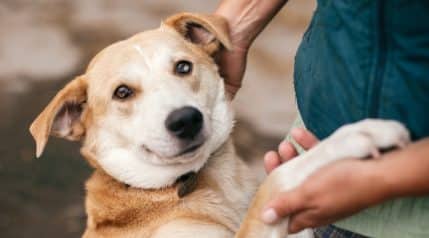Are you wondering whether the Border Terrier might make the best family pet for you and your loved ones? This breed profile is a one-stop-shop breed guide for anyone looking to take this lil’ pup on. They might be small and inconspicuous-looking, but they are anything but ordinary. For many, this dog is not the right option, but for you, they may be perfect.
These dogs are happy-go-lucky pooches who live life to the fullest. They are full of cheeky Terrier personalities, a hunting dog work ethic, and frenetic energy that needs an outlet. If left under-exercised, expect them to destroy your possessions and escape daily. But you can expect tons of fun, love, and canine companionship, all packed into a cute package.
While you don’t need to have lots of previous dog experience to take care of this dog, you need patience and the time and energy to spend with them. Let’s dive into their history, personality, exercise needs, puppy information, and more to help you discover whether you’re the right person to take on a Border Terrier.
Breed History

The Border Terrier comes from the hilly countryside near the Scottish-English border. Many centuries ago, farmers created agile and hardworking terriers to find and eradicate the powerful and sheep-stealing hill fox. The terriers needed to be small enough to dig into fox lairs but had long legs to keep up with foxhounds and huntsmen on horseback.
These dogs were the ancestors of the breed that we know and love today. The dogs had incredible stamina, a desire to find the fox no matter what, and were capable of climbing any wall and getting through any wire entanglements. They were so determined to find the fox that they would stay underground overnight until the fox came to the ground. There weren’t many farmers in the North-East of England without a Border Terrier in their ranks.
Fox hunting was made illegal in England in 2002, but this hasn’t made the Border any less popular in England. However, they are less well known in America and usually find themselves between 80th and 90th place in the American Kennel Club (AKC) popularity ranks. The first Border Terrier, Netherbuyers Ricky, was registered in 1930 in the US.
Temperament

Border Terriers are prized for being pocket-rocket pups who are full of bouncy beans. Despite their small size, they need lots of stimulation and exercise to keep themselves happy. This translates into an exciting and fun pooch to invite into your home. Excellent for any family looking for a sibling for their kiddos or an adventure partner. Not so great if you’re seeking a chilled lapdog.
Their high prey drive means that owners need to be constantly alert when out in a public space. They go after all non-canine furries, so you need to invest in an escape-proof harness to keep them under control. There are not many Border owners brave enough to let them off-leash. So, if you’re looking for an always obedient off-leash pooch, the Border is not the one for you.
Borders bark at everything that comes into their yard, making them fantastic watchdogs. However, they are also pleasant and friendly with everyone. Including strangers or intruders who greet them with a belly rub, so they do not make excellent guard dogs despite being a vocal breed. Their friendliness is one of the characteristics that breed lovers adore so much.
As long as their exercise needs are met, they crave cuddle time on the sofa. They are super sweet pups who are needy when it comes to human contact and comfort. The second you touch the couch is the moment they leap on your lap. This is surprising for many who assume that they just want to be out on the field hunting foxes and other creatures.
Thankfully, unlike other comfort-craving dogs, they aren’t needy enough to worry when you are out of sight. They are resilient and fearless dogs who are happy to spend several hours alone without suffering from separation anxiety. Their adaptability and well-balanced nature are other reasons why they make ideal family pups for the average family.
Size And Appearance

Considered a small dog breed, they usually weigh between 11.5 and 15.5 pounds and measure 12 to 15 inches tall. Borders are typically tall for their size, and this is because they were bred with long legs to keep up with the leggier Foxhounds during fox hunts.
As well as their slender legs, Borders have another unique characteristic that sets them apart from other tiny terriers. They have a distinctive head shape that many describe as being similar to an otter’s head. They have triangular drop-down ears, and in the breed standard, their eyes are described as “full of fire and intelligence.” They look sporty and always ready for action.
If you want to show your dog in the show ring, they must stick to the appearance rules (or as close to) found in the Border Terrier breed standard. Those that deviate more than others might have a hard time winning conformation awards. However, if you are looking for a family pet instead, deviation from the appearance standard is not that significant. A well-balanced typical Border personality is much more important for families.
Coat And Colors

This type of Terrier has a short and dense undercoat covered by a wiry, coarse, and bristly top coat. Other than tidying up feet, head, and neck, Borders do not need trimming or tidying. A natural state is crucial for those who take part in dog shows. Although their coat is wiry and wild, it should not be wavy or curly.
These dogs have four accepted colors that are common in the Border breed: red, blue and tan, grizzle and tan, and wheaten. However, Borders can also be other combinations of these colors. The color grizzle is a mixture of earthy colors that appear to be one color from afar. Typically, the ears and muzzles are darker than the rest of their coat, with black being preferred for show dogs.
Exercise Requirements

They need around 45 minutes of intense exercise a day to stay healthy and happy. With that being said, they could easily keep going for much longer if you have the time – they would love it too. Letting them burn off steam in a doggy park or playing fetch in a contained field is a great way to keep them fit.
After their daily outdoor adventures, they still need more exercise back at home in the form of playtime. Whether it’s an interactive activity with the family or solo playtime, they become bored quickly without it. And a bored Border is something to avoid. It’s in their nature to chew, dig, bark excessively, jump, and destroy things. So, if you can’t provide them with their basic exercise needs, please don’t take this pup on.
Living Conditions

They are country doggos at heart, but they could happily live in a city area or small apartment as long as their exercise needs are met. Ideally, they would like access to a private yard to play and patrol, but this is not a necessity compared to other breeds. Their easy-going nature is what breed fanciers adore.
Border Terriers get along well with other dogs. Of course, they need the proper socialization as a puppy. Still, generally speaking, this breed loves the company of other dogs. They are also fond of children, thanks to their silly and playful nature. Although you need to supervise any dog with kiddos, this pup makes an ideal sibling for children. They might be bouncy, but their smaller size is perfect.
However, there are a few things that they do not tolerate. This type of dog needs a family with lots of time and energy to play and exercise them. As you are learning, this is no couch potato pooch. With an insanely high prey drive means, they also cannot live with tiny creatures. They may live with a cat if raised alongside them, but this is not a given. Non-canine multi-pet households need to carefully consider inviting this pooch into their house because it may not end well.
Training

They love to please their master and are tenacious in achieving the end result, making them trainable and obedient pups. This is ideal for first-time dog owners looking for a relatively smooth introduction to the world of doggy training. But don’t see them as an easy ride – all dogs need training.
Border Terriers respond well to positive reinforcement rather than strict or harsh training. The trick to successfully training your Border is to find out what motivates them, be it yummy treats, toys, or praise, and use it during training. The earlier you start training your Border, the more success you are likely to have.
The Border might get along with everyone (excluding foxes and other prey, of course), but they still need to be socialized from a young age. Mix them with as many other humans, dogs, and experiences as you can when you bring them home as a puppy. The crucial stage for effective socialization is 3 to 12 weeks. Adequate training increases their confidence and their friendliness as an adult.
Introducing the “quiet” and “leave it” commands are a blessing in disguise for many Border owners. They are excessively vocal when they see something outside of their home or are bored, so the quiet command should prove helpful. And similarly, the leave it command comes in handy for when they start chewing or digging something they shouldn’t be.
Health

The Border Terrier is a relatively healthy dog breed that typically enjoys a long lifespan of 12 to 15 years. Although your Border might not suffer from one of these common health conditions, this summary will help you understand the ailments to keep an eye out for.
Hip Dysplasia
This is one of the most common health concerns found in the doggy kingdom. Hip dysplasia can be inherited from parents, so it is crucial to obtain hip reports from breeders. Or it can result from rapid or abnormal skeletal growth as a puppy. Over time it compromises mobility and causes painful arthritis, sometimes requiring surgery. Symptoms include abnormal rear limb movement, stiffness, and general pain.
Eye Conditions
The most common eye concerns in the Border bloodline are juvenile cataracts and progressive retinal atrophy, although there are a few others. Both of these problems can lead to a total loss of vision if not treated. So be sure to look out for symptoms such as a change in appearance, including a blue cloud-like film, squinting or light sensitivity, and pawing at them excessively.
Patella Luxation
This is another common problem typically found in smaller dog breeds, like the Border. This occurs when the kneecap does not sit on the joint correctly, essentially floating. It is relatively painful and could require surgery to fix. Symptoms are similar to hip dysplasia and kicking out in pain as though they are trying to click the joint back into place.
Cardiac Concerns
This dog is predisposed to many heart defects, usually discovered through routine health checks at the vets. If not picked up early, it can lead to your dog becoming lethargic, intolerant of exercise, weight gain, or fainting. The most common concern is pulmonic stenosis, where the valve narrows, putting extra strain on the cardiac system.
Seizures
Border Terriers tend to experience seizures more than the average dog breed. Seizures are caused by many factors but can usually be managed with medication once investigated. Symptoms of seizures include trembling, sudden stiffness, urination, or loss of consciousness.
Nutrition

It’s important not to scrimp on poor-quality nutrition as this can lead to poor health and an unhappy dog. Choosing a high-quality kibble made for small breeds or a fresh food-subscription service such as Ollie can make a world of difference to your dog’s health.
You can expect to feed your Border anywhere between one and one and a half cups a day, depending on their size, activity levels, and age. Terriers have a reputation for being greedy gannets, so don’t be tempted to feed them more than you should. Otherwise, you risk them becoming an overweight, banana-shaped Border with a higher risk of weight-related disease and illnesses.
Grooming

The Border Terrier doesn’t have an intense grooming schedule. They usually need hand-stripping twice a year and brushing once a week to keep them looking their best. They have a double coat that sheds seasonally, so you might have to brush them a little bit more during the shedding seasons.
Hand stripping is the process of plucking dead hairs, which is usually a grooming technique saved for wire-coated dogs. Some owners invest in a stripping knife or a stripping tool. If you do not know how to hand strip a coat, find a trusted groomer who can teach you or take the twice-yearly job on. You can opt to clip the coat if you don’t plan to show your dog in the ring. But this ruins the wiry texture, making it soft and less weather-resistant too.
Other grooming requirements include regular dental cleaning. Smaller dogs are prone to periodontal diseases more so than larger breeds because their mouths are tightly compacted. Expect to brush their teeth with doggy toothpaste several times a week. Exposing them to their grooming regime as a puppy makes them more comfortable with the process. So be sure to include this in your puppy training.
Breeders And Puppy Costs

Your search for a Border Terrier breeder might be more time-consuming. Plus, you might have to travel further afield to meet them. However, it’s super important to work with a reputable and responsible breeder to ensure the health and well-being of your new puppy.
The average price for a puppy usually falls between $800 and $1,500. The actual price changes from state to state, depending on the breeder, pedigree, and demand. The AKC lists Border Terrier breeders, and this is a great place to start your research. Always meet the puppies, at least one parent, and the breeder in person to get a feel of their breeding practices and environment.
Although we all like to save money, buying a cheaper puppy usually means that the breeder is less experienced, does not screen for health problems, and is less concerned with socializing the puppy. This means you are more likely to buy an ill or under-socialized pup who might cause problems for you in the future. It usually means spending more on fixing the issues in the long run, so please do not be tempted to work with irresponsible breeders.
Even for small dogs, puppy costs can be high. On top of the initial puppy price, you need to buy everything you and the puppy needs. You need to consider the cost of crates, beds, toys, harnesses, food, insurance, and much more. You also need to Border-proof your home and yard to ensure that they cannot escape. Sure, they might not be as expensive as a Mastiff, but they still command financial responsibility and resources.
Rescues And Shelters

Welcoming a puppy into your home is not the right option for everyone. Sometimes adopting an older dog in need is the better choice for some families. The cost of rescuing a dog is usually less expensive compared to purchasing a puppy.
Sadly, many families take on the Border thinking that, because they are small, they do not need much exercise and cannot do much damage to their home when bored. This means that many families surrender their Border to rescue shelters, and there are nearly always Borders needing rescuing. Either visit your local shelters or visit the Border Terrier Club of America website for information on this breed’s rescue and available dogs.
As Family Pets
Here’s some general info and to summarize. They are:
- A small dog who is relatively adaptable to most single-pet family environments.
- Capable of living in small apartments or large homes, in the city or the countryside.
- Very active dogs that need a minimum of 45 minutes of intense exercise and additional play sessions throughout the day.
- An extremely high prey drive, so stay on high alert when walking and keep them on a leash. Should not live with small, furry creatures either.
- High energy and small frame mean they are tons of fun for the whole family.
- Vocal dogs who bark at everything that visits their home.
- Sweet and affectionate dogs who need plenty of cuddles.
- Friendly and accepting of strangers.
- Prone to chew, dig, jump, and destroy everything in their pathway when boarded.
Final Thoughts
The Border Terrier is a small dog full to the brim of fun terrier character, tenacity, and cheekiness. They are energetic, making them ideal companions for active families. They also like to play lots, which is why they are excellent choices for families with young children and other dogs. They are friendly with everyone they meet and are generally happy-go-lucky pups.
Although they are relatively simple to train and take care of, if you cannot provide them with their basic needs, they become devilish doggos. It is in their nature to chase and dig, and they prove to you just how good they are if you neglect them and their requirements. But if you can offer them everything they need and more, they are certainly rewarding family pets.





